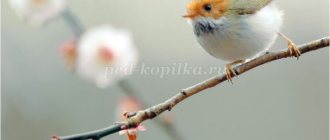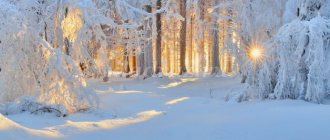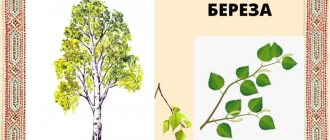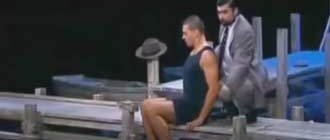Lesson summary for the senior group on the topic: Birds
Lesson notes. Topic: “Let's talk about birds”
The summary is intended for preschool teachers.
Objectives of the lesson: • deepen and expand children's knowledge about birds; • explain the reason for bird migration; • learn to distinguish birds from other animals; • enrich and activate children's speech; • Cultivate a kind, caring attitude towards feathered friends, a desire to help birds during a difficult period for them. Preliminary work: • bird watching on a walk;
• looking at illustrations with birds; • learning the outdoor game “Birder Catcher”; • asking riddles • reading fiction about birds. Progress of the lesson:
- Guys, guess who we will talk about today in class.
Riddle: “We differ in color, you will meet us in winter and summer. If we flap our wings, we will be in the blue sky. We can chirp, croak, sing and coo. You will feed us in winter. Children, who are we? name it." (birds) - What birds do you know? (children take turns naming one bird at a time) - Well done, you know a lot of birds. This means that it will not be difficult for you to guess my riddles. 1. How would a crown suit me? — The Crow croaked importantly 2. Who, without notes and without a pipe, is the best at trilling, more vocal, more tender? Who is this? (Nightingale) 3. If it wants, it will fly straight, If it wants, it hangs in the air, it falls like a stone from the heights, and in the fields it sings and sings. (Lark) 4. It flies all night - it gets mice. And it becomes light - Sleep flies into the hollow. (Owl). 5. If I knock, my head hurts, but if I don’t knock, I’m hungry. (Woodpecker). 6. Lives in the forest, Howls like a robber, People are afraid of him, And he is afraid of people. (Owl). 7. He knocks all the time, he hammers trees, but he doesn’t cripple them, he only heals them. (Woodpecker) 8. A spotted bird laid an egg in someone else’s nest. (Cuckoo). 9. In the summer they follow the plowman, but in the winter they leave screaming. (Rooks). 10. Stands on one leg, looks intently into the water. Poking at random with its beak - Looking for frogs in the river. A drop hung on my nose. Do you recognize? This is... (Heron). 11. And he doesn’t sing, And he doesn’t fly, Why then do they consider Him a bird? (Ostrich). 12. Who, without notes and without a pipe, plays trills best, more vocally, more tenderly? Who is this?.. (Nightingale). 13. The motley fidget, the long-tailed bird, the talkative bird, the most talkative. (Magpie) - What will happen if we don’t have birds? (children’s answers) - What can we do to prevent birds from disappearing? How can we help them? (build birdhouses, make feeders, etc.) So that flowering gardens do not die in vain from harmful insects. Always, at any time of the year. Take care of all kinds of birds, friends. — With the onset of cold weather in the fall, the migration of birds begins, this is how it is written in E. Blaginina’s poem: Soon white snowstorms will raise the snow from the ground. The cranes are flying away, flying away, flying away. You can’t hear the cuckoo in the grove, And the birdhouse is empty, The stork flaps its wings - It flies away, it flies away. A patterned leaf sways in a blue puddle on the water. A black rook and a black rook are walking in the garden, along the ridge. The rare rays of the sun, crumbling and turning yellow, The rooks are flying away, flying away, flying away. — Guys, what birds is this poem about? (about migratory birds) - The first to fly away from us are the fast-winged birds. These are swifts, swallows, starlings, larks. They fly away at the end of August, because... many insects disappear. These birds feed on insects and are called insectivores. — On the golden autumn days, the cranes gathered to fly away. They circled over their native swamp, gathered in schools, and headed to distant warm countries. The strongest one flies ahead - the leader. Wild geese and ducks fly away later than everyone else - when rivers and lakes freeze. These birds are called waterfowl. - Let's try to fly like the birds Fizminutka. The little birds were flying. How they flew All the people looked. As they sat down, all the people were amazed. They sat down, sat, soared, flew, and sang songs. - When will the birds return? (spring) - Let's play the game “The birds have flown!” and find out what birds will fly to us in the spring. I will read a poem, and you listen carefully and if you hear a word that does not name a bird, then you need to clap your hands. Birds have arrived: Pigeons, tits, Flies and swifts... (children clap, flies) And who are the flies? (insects) Birds arrived: Pigeons, tits. Storks, crows, Jackdaws, pasta! (children clap, pasta) Birds have arrived: Pigeons, tits, lapwings, siskins, jays and grass snakes. (children clap, snakes) Birds have arrived: Pigeons, tits, Seagulls, pelicans, Mikes and eagles. Pigeons, tits, herons, nightingales, perches and sparrows. (children clap, perches - fish) Birds have flown in: Pigeons, tits, Ducks, geese, owls, swallows, cows. (children clap, the cow is a beast) Birds have flown in: Pigeons, tits, lapwings, siskins, jackdaws and swifts Mosquitoes, cuckoos ... (children clap, mosquitoes are insects) Birds have arrived: Pigeons, tits, Jackdaws and swifts, Lapwings, siskins, Storks, cuckoos, Swans, starlings... Well done to all of you! — A bird is a beautiful creation of nature. Many songs, poems, legends, and fairy tales are written about birds. — Guys, what fairy tales do you know where birds are found? (children’s answers, the teacher adds) — I suggest playing the outdoor game “Birder Catcher.” The players choose the names of the birds whose calls they can imitate. They stand in a circle, in the center of which is a blindfolded birdcatcher. The birds walk, circle around the bird-catcher and say: In the forest, in the little wood, On the green oak tree, The birds sing merrily. Oh! The bird catcher is coming! The bird catcher claps his hands, the players stop in place, and the driver begins to look for birds. The one he finds imitates the call of the bird he has chosen. The birder guesses the name of the bird and the name of the player. The player becomes a bird catcher. Players should not hide behind objects encountered along the way. Players must stop in place exactly when signaled. “Not all birds fly away; there are those that stay with us for the winter. What are their names? (wintering, sedentary) -What wintering birds do you know? (they will list the wintering birds of our region). — Why do they say that winter is a difficult time for birds? (children's answers) - How can you take care of them in winter? (children's answers) - What can be used as food for birds in winter? (children's answers) - Indeed, winter is a difficult time for birds, especially if it is frosty and full of snow. Birds cannot find food under the snow. A hungry bird suffers greatly from the cold. Winter days are short, and in order to survive without freezing, you need to eat much more food than in summer. You need to support the birds, make feeders for them and don’t forget to bring food to them. This is a very useful thing. Relaxation. - The birds have flown. They are flying, flapping their wings (children raise their hands up and down) - The wind has risen, it is becoming more and more difficult for the birds to fly! - The rain wet the wings, the wings became heavy (children slowly raise their hands) - It’s very difficult for the birds. “But our birds are stronger than the mighty wind, stronger than the cold rain.” — The wind died down, it gave up. The sun came out. Tired birds fall to the ground. The flock settles down to rest (the children lie on their stomachs, arms to the sides) - Our birds are so tired that they can’t move! — Our birds have warmed up. The feathers have dried up. — The wings are resting. The sun warmed the wings, they became warm. - Legs are resting. The sun warmed my legs and my legs became warm. - The backs are resting. And the backs warmed up, became warm. - The heads warmed up, and they became warm. “It’s so good for our birds to rest.” - Thank you, you did a good job today. Some of the kids with their parents and you and I also made feeders. And now we will go outside together and hang them on a tree, and you promise that every day you will take out food and observe what birds fly to your feeders.
We recommend watching:
Summary of educational activities in the senior group “Journey to a Fairy Tale” Summary of a mathematics lesson for children of the senior orthopedic group Summary of educational and gaming activities in the senior group in the section of the “Childhood” program Synopsis of educational activities for the perception of music in the senior group of kindergarten
Similar articles:
Lesson in the senior group of kindergarten on the topic of February 23
Lesson notes for children of senior preschool age. Topic: Invisible air
Summary of organized educational activities for children of the senior group
Notes for mathematics classes in the senior group
Lesson summary on the topic “Reserve” in the senior group
How do birds live in winter?
How do birds cope with frost in winter? It turns out that they are preparing for winter just like people! How do people prepare for winter? (They change into winter clothes and insulate their homes.) Who else dresses in warm winter coats in winter? (Animals - hares, foxes, wolves) And birds, too, by winter change their plumage to a warmer, thicker and longer winter plumage. Birds have air between their feathers. It keeps the cold out and retains the heat. So they don't freeze!
goshawk
When a goshawk appears, there is a commotion in the forest: you have to hide. Even hares hide on the ground. A goshawk quickly flies between the trees, looking out for prey, and behind it, forest birds fly squeaking and screaming: jays, tits, siskins. The squirrel gapes, does not have time to scurry into the hollow - the goshawk will grab it. From a great height, the goshawk sees the wood mouse, and the black grouse if it is not hiding well. The goshawk is a forest predator.
Capercaillie
Capercaillie is a resident of forest thickets. This is a big forest rooster. In the summer, when blueberries, lingonberries, and blueberries ripen, the capercaillie feeds on berries. And on the banks of streams, wood grouse peck small pebbles so that the pebbles in their stomachs, like millstones, grind the berries. In winter, capercaillie feeds on pine needles.
The millstone stones grind them down. In the spring, as soon as the snow melts in the forest, wood grouse begin to talk - to sing their spring songs. The capercaillie walks on the ground like a turkey, spreading its tail like a fan, and clicking its beak, as if two sticks are knocking against each other. And the song ends as if a knife is being sharpened on a whetstone. At the end of the song, the wood grouse goes deaf, which is why it was called the wood grouse.
Sparrow owl
The sparrow owl is a small nocturnal predator. As it gets dark in the forest, the owl silently flies over forest clearings, over vegetable gardens and listens. A field mouse squeaks, an owl rushes at it and grabs it. Sychik brings his prey to the hollow of an old oak tree. When there are a lot of mice, the little owl stores them in reserve for the winter. In winter, you can find a lot of frozen mice in the hollow - this is what the little owl brought up. The mice gnaw the grain and devastate the fields, and the owl helps preserve the harvest.
Kedrovka
The nutcracker is a taiga bird. They called it that because there are the most nutcrackers in the cedar taiga. As soon as the pine nuts ripen, the nutcracker makes reserves from morning to evening. He stuffs his crop with nuts, and then stuffs them into cracks in the rocks, hides them in the hollows of trees, and buries them in the ground.
In the spring, when the snow melts, the nutcracker often forgets where it buried its reserves, but finds nuts from other nutcrackers and feeds. Squirrels, chipmunks, and mice feed on nutcracker reserves. But many nuts remain in the ground. Small cedars grow from them. This is how the nutcracker plants cedar forests.
Crow
Forest crows live in pairs. And they live for two hundred years or more. A pair of ravens flies over the taiga and carefully inspects every clearing, every stream. If they spot prey: the remains of a deer that was killed by a bear, or a dead fish on the shore, they will immediately let other crows know. “Kruk-krruk-krruk,” the cry of a raven rushes over the taiga, it notifies other ravens that it has found prey.
You will never confuse a hooded crow with a forest raven. The hooded crow has gray and black feathers, and the collar is all black. A crow flies closer to the village in winter, pecking at something in a landfill, but a raven never gets close to human habitation; it is a wild bird of the forest.
Woodcock
Woodcock is a woodland sandpiper. His eyes are as big as two currants, so he can see in the twilight. It will begin to get dark, a woodcock will emerge from the bushes onto the forest road and walk on the ground, feeding. It puts its beak into the soft ground and feels with its beak: if a worm or bug moves nearby, it immediately catches it and swallows it.
And during the day, woodcock hides under the bushes; you walk nearby and won’t see it. If you disturb an aldercock in a nest, it will leave the nest and transfer the small chicks to a new place. Flies over the forest and holds a chick in its paws. Until all the chicks are transferred, the woodcock will not calm down.





